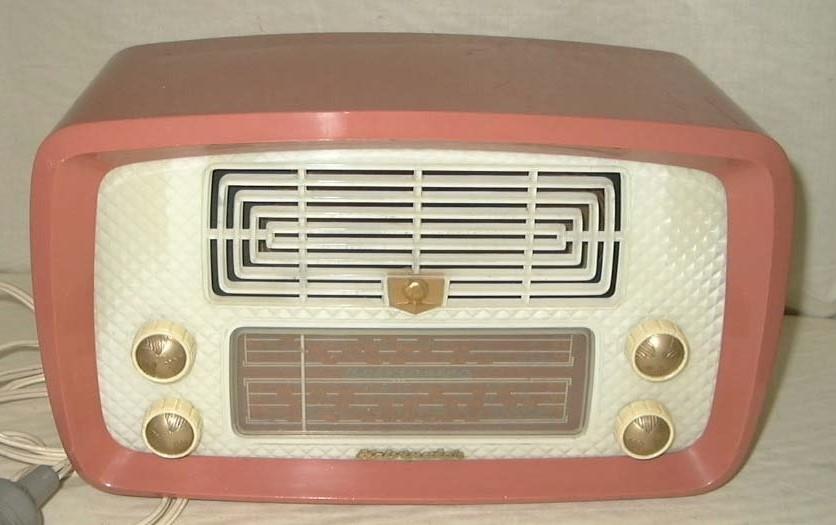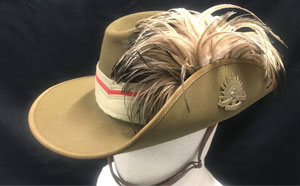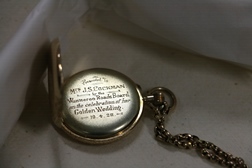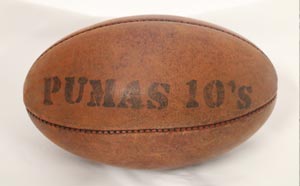Museum Collection Highlights
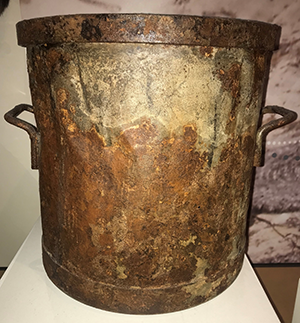
September 2023 Museum Collection Highlight – Toilet can
This month we highlight an unusual object...a toilet can! When the 'night cart' system of waste disposal stopped, the old toilet cans were buried. This can was dug up when earthworks for the new Wanneroo Shopping Centre were undertaken in 2007. The site had been the location of the old depot.
Listen as our 'talking toilet' can describes its dirty job!
Talking Toilet Can Wanneroo Museum from Wanneroo Museum on Vimeo.
August 2023 Museum Collection Highlight – Small Stone Axe
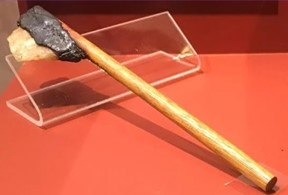
National Science Week is celebrated 12 – 20 August, with this year’s theme focused on innovation. Aboriginal and Torres Strait Islander peoples are Australia’s first innovators and continue to innovate today! Highlighted this month is a small stone axe, donated by Ken Colbung, a Noongar Elder. The stone axe was used for teaching and handing down of knowledge to children.
The resin used to attach the stone to the handle is made from an innovative combination of Balga resin, charcoal, and kangaroo poo! You can watch a video to see how the resin is made: Working with Balga Resin, by Brett Nannup, Western Australian Museum YouTube.
June 2023 Museum Collection Highlight – Bullens African Lion Safari Souvenir Glass
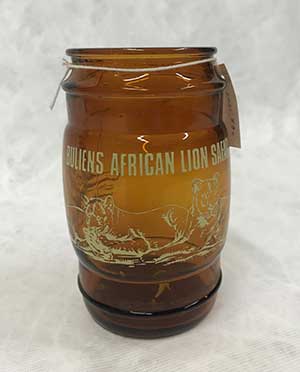
No trip would be complete without a souvenir! This month’s collection highlight features a souvenir glass from Bullens African Lion Safari, when Wanneroo had its very own lion park.
Opened 21 August 1971, the park allowed visitors to view lions from their cars in a bushland setting. Other attractions included a mini zoo with monkeys, kangaroos emus, camels, dingoes, and a variety of birds.
The lion park closed in 1988 due to the high cost of animal feed and public liability insurance.
May 2023 Museum Collection Highlight – Bakelite ‘Kelvinator’ Radio
This unique, pink bakelite radio might have been placed on a mantle in the home, with the family gathered around to listen to music, important news, or be entertained by an evening comedy program. In fact, you can hear from this radio itself! Visit https://vimeo.com/418740636.
Love the video of our “talking” radio? Head to the Wanneroo Regional Museum this May and search for QR codes throughout the museum to virtually interact with our museum collection.
April 2023 Collection Highlight - Volunteer Defence Corps Helmet, WWII
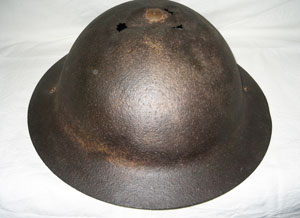
This helmet was used by Wanneroo market gardener Vasil Dhimitri when he was involved in the Australian Volunteer Defence Corps (VDC). The VDC was established in July 1940 and was initially composed of ex-servicemen who had served in the First World War.
Visit Wanneroo Regional Museum this April to view the helmet and learn how World War II had a major impact on the Wanneroo Community.
March 2023 Collection Highlight - Atlantis Marine Park Salt and Pepper Shaker Set
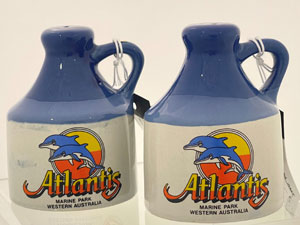
Summer may be over, but our happy memories remain! Perhaps a souvenir or memento was purchased as a reminder of a lovely holiday memory. This month, we highlight a salt and pepper shaker set, one of many souvenirs that could be purchased at Atlantis Marine Park.
Opening at Two Rocks in 1981, Atlantis Marine Park was a popular tourist hotspot. In the first 13 months, half a million people had visited the park enjoying attractions such as the performing seals and dolphins, penguins, and an oceanarium. The park was closed in August 1990, following new regulations regarding the accommodation of marine animals.
Visit Wanneroo Regional Museum to see a pop up display located just outside the Community History Centre. Developed by our Community Historian, Rebecca Balling, the exhibition features photographs and souvenir items that will be on display through the end of March.
February 2023 Collection Highlight - Pie Chimney
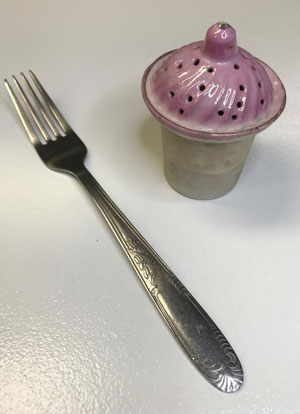
Have you ever used a pie chimney when baking a delicious pie? Also known as pie birds, pie funnels, pie vents, or pie whistles, these quaint kitchen tools were intended to keep juicy fruit and meat pies from bubbling over and keeping the crust crispy. These whimsical figures are actually vents, typically made of ceramics, which allow steam to escape from the pie as it bakes. Today, many bakers avoid using a pie chimney by simply cutting slits or designs into the top crust.
Check out our pop-up cooking display at the Wanneroo Regional Museum featuring this unique pie chimney from the collection, shaped like a pie or tart.
Click below to view highlights from previous years
October 2022 Object of the Month - Tala Cook's Measure
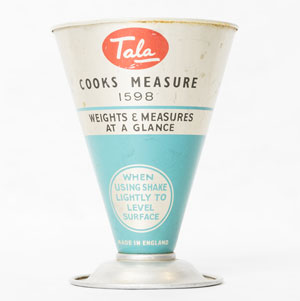
This Tala Originals Dry Cook’s Measure was a versatile measuring cup produced in the 1950s. Made in Liverpool, England, since the early 1900s, these iconic measuring cups are still made today in the same factory. Established in Britain by Frederick Taylor and Thomas Law, Tala became a beloved kitchenware brand that was exported to many countries including Australia, Canada, and New Zealand.
To learn more about the history of Tala and the Cook’s Measure, visit the Tala Cooking website.
This handy measuring tool features American and English cup measures (an English cup is slightly larger), Imperial, Metric, and fluid measures such as pints. Generally used to measure dry ingredients, it could also be used to measure liquids for immediate use, as the seal isn’t watertight!
The Imperial system of measurement uses units such as the inch, mile and pound (weight), whereas the metric system uses units based on multiples of ten such as metre, gram, and litre.
This type of measuring cup would have been particularly useful in Australia during its process of metrification between 1969 and 1977, when the metric system was introduced in stages.
September 2022 Object of the Month - Washstand Set at Buckingham House
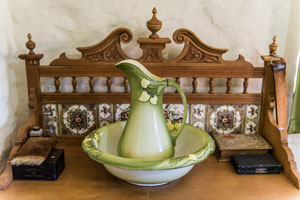
This washstand set would have been a common sight in homes throughout the 1800s and early 1900s. Larger washstand sets provided a place to wash up before modern indoor plumbing and sinks made the washstand obsolete. Washstands could be simple or ornate, with the wash bowl and water pitcher placed on the table. This set, found at Buckingham House, is a beautiful example.
August 2022 Object of the Month - Photograph of the Barone Family
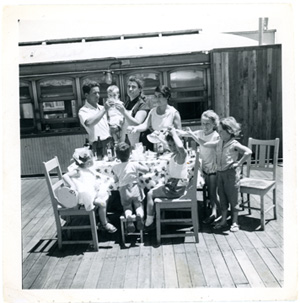
In celebration of Family History Month in August we are featuring a popular museum object of the month that previously appeared in February 2020.
Michele Barone migrated from Southern Italy to the Nowergup area in 1955 with nothing but a single suitcase. He slept under the trees until he was given work at a nearby limestone quarry.
The owner of the quarry also offered Michele three decommissioned trams, which he converted into a family home for his wife Teresa and eldest daughter Maria who arrived in 1957.
Maria D’Alonzo (née Barone), the donor of this photograph, still has “vivid recollections of dad working in the quarry and our home which had 48 windows. Where the tram's engine was, had been converted to mum's kitchen. The middle of the tram was our eating area and the end of the tram was the sleeping quarter.”
This photograph and other fascinating migration stories can be found in the ‘Making Wanneroo Home’ exhibit in the Wanneroo Regional Museum.
July 2022 Object of the Month - Yanchep rowboat
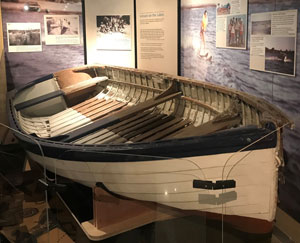
From the 1930s, one of the most popular activities at Yanchep National Park was to take a rowboat out onto Loch McNess.
The first rowboats were clinker built and these were used until the 1970s. This is the only clinker rowboat from the park still known to exist.
Half of this boat was restored to show the difference between the boat at its best compared to years of use.
In 1996, the rowboat went on display at Gloucester Lodge Museum in Yanchep National Park before being donated by the Department of Environment and Conservation to Wanneroo Regional Museum in 2010.
Explore the Wanneroo Regional Museum during school holidays to learn more about this boat and how people holiday in Wanneroo from past to present!
May 2022 Object of the Month - Gloucester Lodge as a museum
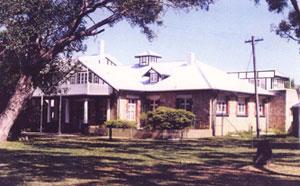
After serving as a guesthouse for many years, a lack of maintenance resulted in the State Government’s decision to demolish the building.
The Wanneroo community fought to save it from demolition and the then Shire of Wanneroo negotiated a lease of the building.
In 1979, this historic building opened as a museum. The museum operated from 1979 to 2005 when it closed pending the construction of the new Wanneroo Regional Museum, which opened in 2009. Gloucester Lodge is currently undergoing renovations.
April 2022 Object of the Month - Army Slouch Hat, 10th Light Horse
During World War II, the men of the 10th Light Horse made their home in the bushland of Wanneroo. Strategically located between the coast and Pearce Air Base, members of the 10th and their mounts played an important role in protecting the shore of Western Australia from the threat of an enemy attack.
The slouch hat and its Rising Sun badge became symbols of the men of the Australian Army during both World War I and World War II, and continues to be worn today by Australian Army personnel. Learn more about the history of the slouch hat and see this illustrious object for yourself at the Wanneroo Regional Museum this April.
Looking to spend some time outside? Follow the 10th Light Horse Heritage Trail just north of the Flynn Drive and Wanneroo Road intersection, which provides a lasting tribute to the regiment.
The famous khaki felt hat was fist adopted into Australian military service in 1885 when it was chosen for the newly-formed Victorian Mounted Rifles. This hat was an ordinary bush felt hat turned up on the right side. The intention of turning up the right side of the hat was to ensure it would not be caught during the drill movement of “shoulder arms” from “order arms.”
By 1890, State military commandants had agreed that all Australian forces, except the artillery corps, should wear a looped-up hat of uniform pattern that was turned up on the right side in Victoria and Tasmania, and on the left side in all other States to allow for different drill movements.
The Defence Act of 1903 combined the former colonial defence forces into a single Australian army. The Slouch hat became standard issue in 1903 and its brim position was mostly standardised and now universally turned-up on the left hand side.
The Emu Plume
The tradition of wearing emu feathers in the slouch hat originated with the Queensland Mounted Infantry during the Great Shearers’ Strike in Queensland in 1891. During this time, the Queensland Mounted Infantry were called out to aid the Civil Power.
In recognition of its service, the Queensland government permitted the Regiment to adopt the plume as part of its uniform.
In 1915, then Minister for Defence, Sir G. F. Pearce, granted all units of the Australian Light Horse permission to wear the plume, which they refer to as ‘Kangaroo feathers.’
Today, emu tufts of approved design and dimensions are now worn by all members of the Royal Australian Armoured Corps as an item of dress.
10th Light Horse in Wanneroo
Six thousand soldiers were based at the first 10th Light Horse camp located to the east of Wanneroo Road in Ashby. This strategic position was chosen for its location between the ocean and the Pearce Air Base. The regiment’s role was to protect our coastline from the threat of enemy attack.
The 10th Light Horse later had another camp to the west of Wanneroo Road – now marked by the commemorative heritage trail. This site had a cook house, administration area, ammunition dump and stores, as well as a large area dedicated to manoeuvres, the horse lines, and a tent for the farriers.
December 2021/January 2022 Object of the Month - Watkins’ Beach Shack – donated by David Watkins
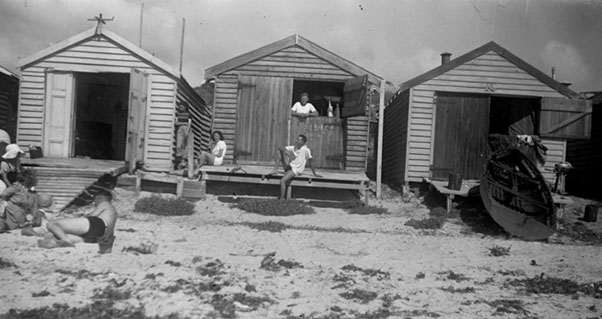
David Watkins’ shack at Marmion Beach Picture Wanneroo Image PD00064. Reproduced courtesy of Wanneroo Regional Museum.
Dreaming of a holiday at a beach shack? Worried it will be too hot? Come inside the Wanneroo Museum and stay cool while exploring Watkins’ Beach Shack!
From Marmion, to Quinns Rocks, and now residing at the Wanneroo Regional Museum, this shack was originally one of many at Marmion beach before David Watkins moved it to Quinns Rocks in 1952. The original design appears to have been used more as a boat shed; both side and end sections were later added by the Watkins.
As a keen fisherman, David Watkins first visited Quinns rocks in 1950. He had to drive on sand tracks with access through the Mindarie Pastoral company land, which was owned by John Clarkson (a former 10th Light Horse Major). It meant unlocking many gates and getting bogged on the way.
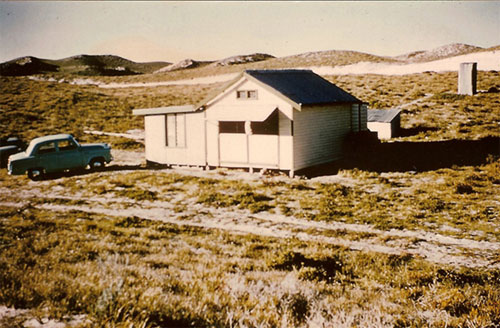
David Watkins’ shack at Quinns Rocks Picture Wanneroo Image PD00074. Reproduced courtesy of Wanneroo Regional Museum.
October 2021 Object of the Month - Alkimos Log Books
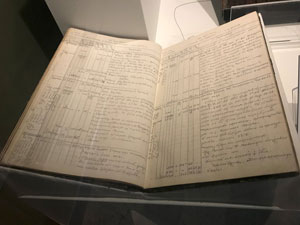
A Ghost Ship? The Alkimos, a Greek freighter and former Liberty ship, ran aground for a second time after breaking towlines and now resides off the coast of Shorehaven Beach at the end of Shorehaven Blvd. There are stories of a ghost roaming the decks of the Alkimos. “…tools and equipment simply vanished. Cooking smells wafted from empty and powerless galleys. Claims of strange mysterious deaths, sickness and injury, ghosts and associated exotic ghost stories plagued the wreck of the ex-World War II Liberty ship.” – Jack Sue
In light of Halloween this month, stop in for a spell to view the Alkimos Log Books and learn about the rumours of a ghostly man wearing oilskins on board. Happy Haunting!
Want to read more ghost stories? Pick up a copy of “Ghost of the Alkimos” by Jack Wong Sue DCM JP & Barry Sue, available to purchase in the Community History Centre.
September 2021 Object of the Month - Teacup and Saucer – Donated by Lucy Jarvis
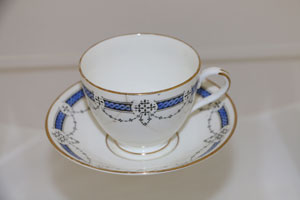
Imagine picking up your life and moving to another country. Would you travel alone or with your family? What would you bring if you could only take one suitcase? Many migrants bring treasured personal items and photographs to remind them of family, friends, and memories from their former homes.
In the Wanneroo Museum’s Making Wanneroo Home exhibit, Lucy Jarvis donated this teacup and saucer, part of a set that belonged to Lucy Jarvis’ great grandmother. “It took five years to feel like Australia was home and to realise I wouldn’t be moving back. Much of the extended family still lives in Zimbabwe, so my home is full of mementoes and gifts from relatives.”
Approximately 43% of Wanneroo’s residents were born overseas (2016 Census, Australian Bureau of Statistics). From First Nations peoples, to early migrants, to new migrants, we are a diverse community of people from all over the world. Visit Wanneroo Museum to read more about Wanneroo’s migration history and the many stories that bring us together as a community!
August 2021 Object of the Month - Betty Colbung’s Buka; Kangaroo Skin Cloak – Donated by Ken Colbung
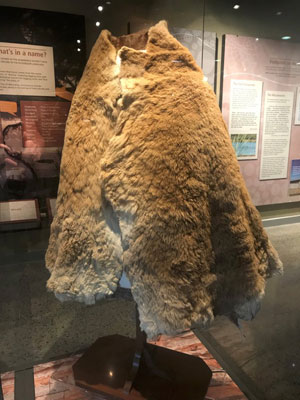
This August, we recognise International Day of the World’s Indigenous People, observed on the 9th of August. We honour this day by selecting Betty Colbung’s Buka as the Museum Object of the Month, an item of cultural significance which we are privileged to have on display at the museum.
The Buka is beautifully hand-crafted and has a wonderful family history. Betty’s daughter, Esandra, spoke with one of the City’s Heritage Education Officers about the Buka and how “…the Buka was handed to mum through my dad's aunties. I've actually been giving to my kids, Bukas from my dad…and grandson, he's got one as well. So, it's been somewhat of a tradition in our family, the Buka…it holds much pride with us.”
July 2021 Object of the Month - Hoovermatic Twin Tub Washing Machine - donated by Colin Allen
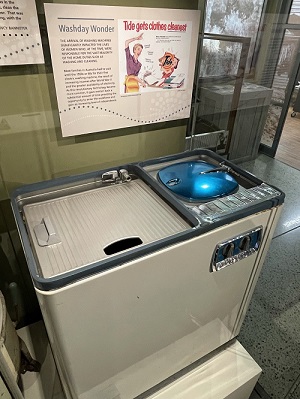
School holidays are a wonderful time to explore your own backyard, take a vacation, or enjoy some relaxing time at home with your family. Imagine spending an entire day during the week tending to washing!
Doris Steele stated her mother, Eva (Cockman) Duffy-Lawrence “…boiled the clothes in four-gallon kerosene tins and did all the washing by hand in a big tub…She scrubbed the clothes with a scrubbing board and it took all day to do the washing” (pg. 15, Stories of Old Wanneroo, As told to Bill Marwick).
With the invention of electric washing machines, like the Hoovermatic Twin Tub, laundry day labouring was greatly reduced. Washing and spin drying could be completed using one machine, however, articles still had to be manually transferred from the washer to the spin dryer.
Visit us at the Wanneroo Regional Museum to see this time-saving invention and how times have changed!
January 2021 Object of the Month - Red Cross nursing uniforms
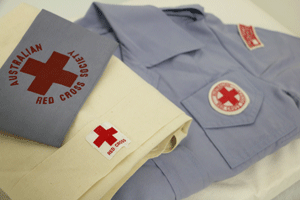
In 2020, the Australian Red Cross kindly donated pieces of historical nursing uniforms to the Wanneroo Regional Museum for use in exhibitions and in our popular Museum in a Box program that goes out to local schools.
In a year that has been defined by the COVID-19 pandemic, it seemed only right that we should highlight this generous donation and as the year draws to a close, pay tribute to our health heroes to whom we all owe an enormous debt.
November 2020 Object of the Month - Wedding dress of Concetta (Connie) Ariti
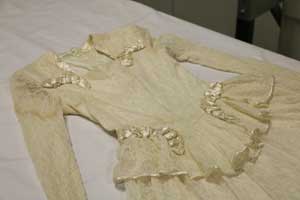
This beautiful dress was worn by bride Concetta (Connie) Ariti in her wedding to Sjephan (Steve) Budrovich at Tuart Hill on 29 September 1951 and was recently generously donated by Connie’s daughter Marie along with images of the big day.
Connie was the daughter of Joe and Rosaria Ariti who arrived and settled in Wanneroo in the 1920s. You can see an image of the beautiful bride in her dress by visiting the Wanneroo Library website.
October 2020 Object of the Month - Commodore 64 Computer
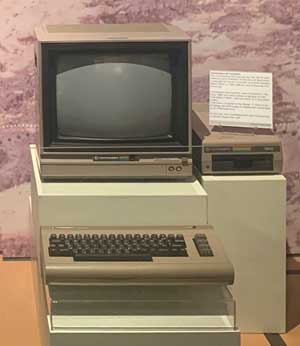
A new edition to the collection, this month we feature this Commodore 64 computer, the first PC ever used by a Shire President of the Shire of Wanneroo. It was used by former Councillor and Shire President, Mike O’Brien in 1982-1986 for council business and home use and then donated by him in 2013.
Commodore 64 computers were introduced in the early 80s and were named so because of their total 64kb of RAM – the equivalent of a long email today! They were compared to the Model ‘T’ Ford car for bringing new technology to middle-class households at an affordable price. To this day, the Commodore 64 is the most popular computer model ever sold.
The amazing video below illustrates just how ‘Totally Rad’ this early 1980s model is.
August 2020 Object of the Month - Wanneroo Coat of Arms
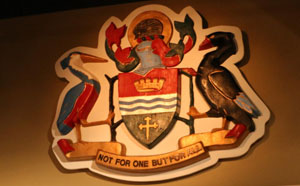
This month we feature a very recent addition to the Museum, the Wanneroo Coat of Arms. Originally on display from 1985 outside the City of Wanneroo Administration building in the then suburb of Joondalup, the crest was removed when the offices transitioned to the City of Joondalup following its formation in 1998. In 2019 the crest was rescued from disposal by the City of Joondalup and restored before being formally handed back to Wanneroo on 25 February 2020.
Now on display in the Wanneroo Regional Museum, the coat of arms forms part of the ‘new City of Wanneroo’ exhibit and includes a detailed explanation of each of the elements of the crest.
May 2020 Object of the Month - Soap saver/soap shaker
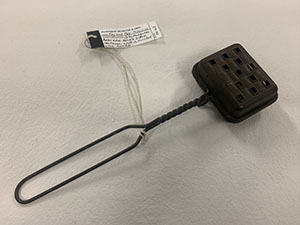
This type of soap saver was common in the early to mid-20th century and is an example of the way that people in the past used up left over pieces of a bar of soap. The pieces would be placed in the cage and vigorously shaken in the water to create suds for washing dishes or other cleaning purposes. This way, even small pieces could be re-used and there was less waste.
Soap savers were replaced c1950s by the advent of liquid soap and detergent in plastic bottles. They have recently had a resurgence with people looking to minimise their plastic waste.
This example was donated by Roy and Joy Mullins in 1984 and was used in the Yanchep area.
February 2020 Object of the Month

Michele Barone migrated from Southern Italy to the Nowergup area in 1955 with nothing but a single suitcase. He slept under the trees until he was given work at a nearby limestone quarry.
The owner of the quarry also offered Michele three decommissioned trams, which he converted into a family home for his wife Teresa and eldest daughter Maria who arrived in 1957.
Maria D’Alonzo (née Barone), the donor of this photograph, still has “vivid recollections of dad working in the quarry and our home which had 48 windows. Where the tram's engine was, had been converted to mum's kitchen. The middle of the tram was our eating area and the end of the tram was the sleeping quarter.”
This photograph and other fascinating migration stories can be found in ‘Making Wanneroo Home’, the newest exhibit in the Wanneroo Regional Museum.
January 2020 Object of the Month
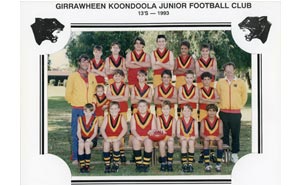
Girrawheen/Koondoola JFC ‘Pumas’ Team Photo
There may be a few familiar faces in this team photo from the Girrawheen-Koondoola Junior Football Club U13s in 1993.
Girrawheen Junior Football club and Koondoola Junior Football Club amalgamated in 1991 to become the Pumas. After the club disbanded in the early 2000s, a number of items were salvaged from the old clubhouse at the Dennis Cooley Pavilion in Girrawheen and were then donated to the Wanneroo Regional Museum.
Some of these items will be on display for a short time at Girrawheen Library this January. Visit Girrawheen Library from 17th Jan to 12th Feb 2020 to see some amazing objects and photos from the club’s history!
If you have any further information about Girrawheen-Koondoola Junior Football Club, we’d love to hear from you! Drop us an email at museum@wanneroo.wa.gov.au
December 2019 Object of the Month
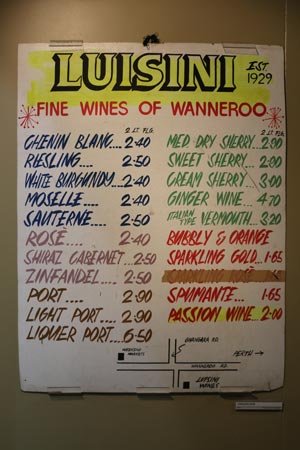
Luisini 'Fine Wines of Wanneroo' Sign
Prominent Italian shopkeeper Ezio Luisini established the Luisini Winery in the (then) Shire of Wanneroo in 1929. At 100 acres (40 ha) it became the largest, privately owned vineyard in Western Australia.
Ezio also owned a large and successful shop in William Street, Northbridge which became the first port of call for new Italian migrants, he gave them advice, answered their questions, offered favourable credit and even stored their luggage for them when they went out to find work. After Ezio’s death in 1964, the winery came under the care of the Mondello family and closed in the late 1980s.
The building still stands beside Lake Goollelal in Kingsley and is now managed by the National Trust of WA.
This sign, now in the collection of the Wanneroo Regional Museum, demonstrates some of the fine wines on offer at very reasonable prices!
November 2019 Object of the Month
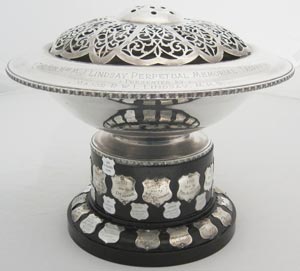
MJ Lindsay Perpetual Memorial Trophy
This beautiful trophy was awarded from 1961 to 2003 to the exhibitor who gained the highest number of points over all sections, excluding ring events, at the Wanneroo Show.
It was donated to the museum in 2013 by the Wanneroo Agricultural Society.
The trophy is dedicated to the Hon. Mrs M.J. Lindsay. The first winner was Mrs Alice Gibbs in 1961, who won the trophy 11 times with her last win in 1987. The last winner was D Trandos & Sons who won the trophy 16 times between 1963 and 2003. Other winners were: A & S Canzirri, Santo Crisafulli, Mrs S.W Mitchell, Jo Bridger, A&R Antulov & Sons and Mrs N Fripp.
October 2019 Object of the Month
This beautiful fob watch was presented to Emma Jane Cockman (nee Edwards) by the Wanneroo Road Board in 1926, to celebrate her 50th wedding anniversary with James Samuel Cockman.
James Samuel and Emma Cockman were married at Gingin in 1877 had 13 children, five daughters and eight sons. Four sons fought in WWI, one didn’t return. James Samuel Cockman was the son of James Cockman, one of the earliest British settlers in the Wanneroo region. The elder James Cockman and his son John built Cockman House which still stands today.
When Emma Jane Cockman passed away in 1947, she left 51 grandchildren and 47 great-grandchildren. 200 Wanneroo residents gathered to celebrate their anniversary.
September 2019 Object of the Month
This football once belonged to the now defunct Girrawheen Koondoola Junior Football Club, the 'Pumas' which disbanded in 2003. Girrawheen Junior Football Club and Koondoola Junior Football Club amalgamated in 1991 to become the Pumas.
This football was salvaged along with trophies, team photos and other memorabilia from the old clubhouse at the Dennis Cooley Pavillion, Girrawheen in 2007. .
August 2019 Object of the Month
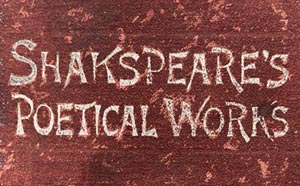
A relatively unassuming copy of the works of Shakespeare takes centre stage this month. Donated by Mary Cook, this book has an inscription written in lead pencil on the inside cover, “Come off A.T. Brown Ship. Owned by Dad.” The task of verifying this claim was taken on by the Museum curatorial team who were able to make a connection between Mary Cook’s grandfather, Charles Ross and the Alex T. Brown Shipwreck.
The Alex T. Brown was a 4-masted American schooner that was blown ashore on 29 May 1917 and wrecked at what is colloquially known as The Spot, near Two Rocks. Charles Ross and his business partner Mr. Ashman subsequently purchased the shipwreck on Mon 18 Jun 1917 at a public auction in Perth for the sum of for £425. They also purchased the ship’s stores for £82. 10s.
Charles passed away in 1948 and upon his death gave the copy of ‘Shakspeare’s Poetical Works’ that was taken from the Alex T. Brown shipwreck to his daughter Violet. Violet passed away in 1975 and the book came to Violet’s daughter Mary Cook, who kindly donated the book to the Gloucester Lodge Museum in 1987. The book is now in the Wanneroo Regional Museum collection.
July 2019 Object of the Month
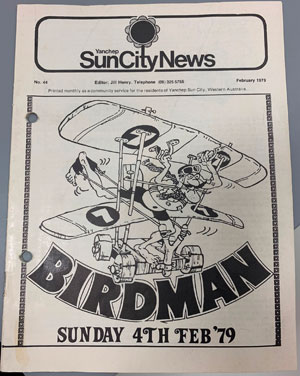
Did you know that the Community History Centre holds a number of local newspapers and gazettes that have been collected since the 70s?
The Yanchep Sun City News is one of these and perfectly captures Yanchep and Two Rocks of the 70s and 80s. This edition from February 1979 focuses on the Birdman Rally which was held at Two Rocks Marina. With a $10 entry fee, participants would bring along all manner of contraptions to attempt to fly the longest distance from the top of a tower. Prizes were given for the most novel entry.
Here’s an excerpt, “Well this year’s Birdman is now almost upon us and all the locals are gearing up for the challenge. Rockers and Goons are not on speaking terms and competition is fierce! The Lions are taking time off from manning their beer tent to put in a challenger and Ray Krakouer has been purchasing some magic anti-gravity powder for his flying carpet…”
Do you have copies of past editions of local newsletters or newspapers you would consider donating? Contact us: museum@wanneroo.wa.gov.au
June 2019 Object of the Month
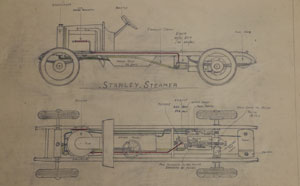
Stanley Steamer Car Plans donated by Henry J. Dennis
The Age of Steam brought with it incredible advances in technology including steam cars, perhaps the most famous of these being the Stanley Steamer Car. This month, we’re highlighting plans of a Stanley Steamer Car, drawn by Henry J. Dennis and donated to the museum in 1984. The Dennis family, pioneers in Wanneroo, used a Stanley Steamer car converted to a utility to transport cases of farm produce to the markets. Henry bought it in a burnt and run down state from Mr Barrett-Lennard of the Swan region in about 1921 and rebuilt it, retaining the original bonnet and constructing a body for carting cases.
Today the car is gone, but the engine is on display at the Motor Museum in Whiteman Park. According to Gloucester Lodge Museum minutes, the engine was also used to pump water and supply lighting through a generator to the mill and family home on Pinjar Road up until 1943. The Dennis family are well known for their ingenuity and inventiveness when it came to machinery, having patented the first power saw in Western Australia in 1923, using a car engine for the motor.
May 2019 Object of the Month
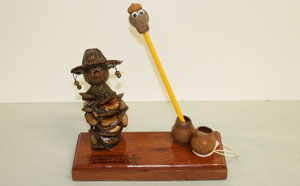
Gumnut Figure, Swagman with Pencil
May’s featured object is a Gumnut figure and pencil holder created by the Gumnut Factory in Wangara. The Gumnut Factory created bushcrafts from wood, gumnuts and seedpods and was started by Chris Trump in March 1979. It was located on Prindiville Drive, Wangara and the business flourished with an Arts and Crafts shop opening in 1980.
The Gumnut Factory featured on several TV shows with Chris publishing a book, “The First Gumnut Factory” and also building Gumnutland model village railway in 1987. Thousands of people visited the factory and the products were exported to the Eastern States. In 2001, Chris sold the business to Anita and Richard Caesar and the factory moved to the Swan Valley in late 2002. The shop in the Swan Valley closed in 2006 and the manufacturing ceased in March 2007.
The Wanneroo Museum has a small range of these creative and collectible figurines in its collection including this month’s object of the month, the swagman.
April 2019 Object of the Month
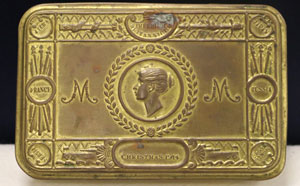
In 1914, Princess Mary, the 17 year-old daughter of King George V held a public appeal to raise funds to ensure that “every Sailor afloat and every Soldier at the front” received a Christmas present.
Princess Mary's gift to WWI soldiers serving on Christmas Day 1914 was a brass tin filled with various gifts, such as tobacco, confectionary, spices, pencils, a notebook, postcards and a picture of the princess. Having used or consumed the contents, soldiers and sailors found the tins useful for carrying other small items.
Wanneroo Regional Museum was recently donated a Princess Mary Gift tin that belonged to Albert Edward Plane, the grandfather of long-time local resident Bernice Marwick. Albert was born in Scarborough, UK on the 14th May 1890 and served in the Royal Navy.
Visit the museum during April to see this object on display outside the Community History Centre.
March 2019 Object of the Month
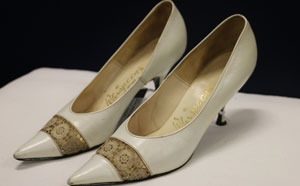
Nancy Bannister’s wedding shoes
Nancy Crisafulli married Frederick Bannister on 4th August 1962 at St Anthony’s Church, Wanneroo wearing a pair of white heels made by Valencia Shoes and bought from Aherns in Perth in July 1962. They cost Nancy £20 and she saved up for ten weeks to afford them.
February 2019 Object of the Month
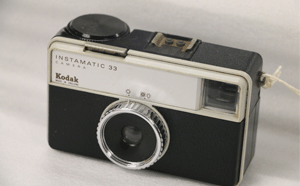
Kodak Instamatic 33 Camera - donated by Don and Marie Menzies
The Kodak Instamatic 33 Camera was one of a range of Instamatic cameras that brought amateur photography to new heights of popularity. It was made between 1968 and 1973 and manufactured in England. It features an easy to use film cartridge that brought amateur photography to new heights of popularity. A simple and affordable snapshot camera, over 59 million Instamatic cameras were produced by 1970. This one has a fixed-focus lens and two-speed shutter which can be selected by weather symbols for sun or cloudy sky.
This camera was kindly donated to the museum in 2000 by Don and Marie Menzies. It is representative of the kind of camera that would have commonly been used in WA in the 1960s and 1970s.
January 2019 Object of the Month
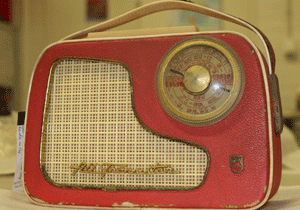
This unassuming little red Philips Model 199 ‘all transistor’ portable radio has a long history in the City of Wanneroo. It belonged to Isabella Gibbs who worked at the ticket box for Crystal Cave at Yanchep National Park for twenty five years. Rangers at Yanchep National Park including Ranger Rollie, Ranger Bennett and Ranger Lenny Gibbs would gather at the Crystal Cave ticket box and listen to the radio for the cricket scores. The Gibbs family are one of Wanneroo’s pioneering families and Isabella and her husband Hilton Gibbs lived in North Carabooda for many years.
December 2018 Object of the Month
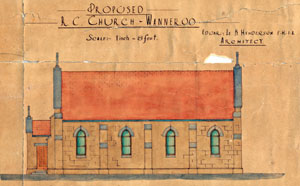
A copy of a manuscript plan of the first St Anthony’s Church is featured this month as part of a new museum display. It was drawn by Edgar Le Blond Henderson, a prominent Perth architect in the 1930s.
As early as 1872, the lack of facilities for Catholics in Wanneroo had been noted. The real need for a purpose built place of worship for Catholic families in the area became apparent with the influx of migrant families after World War 1. This early period of Catholicism in Wanneroo was dominated by names such as Chokolich, Crisafulli, and Parin; Italian, Slav and Macedonian families who had settled in Wanneroo in the early part of this century.
Planning for the building of a church began as early as 1913. St Anthony’s Church was designed by architect Edgar Le Blond Henderson in 1930. Building of the church commenced in 1931, and on Sunday, July 17, 1932, St. Anthony's Church was opened and consecrated by Archbishop Clune. Parish Priest, Fr. Cunningham and his Assistant, Fr. Goody assisted in the official opening. The Church hosted the first mass spoken in Liturgical Slav in Western Australia in 1933, and was the focus of Wanneroo’s various Italian, Slav, Macedonian and English ethnic communities during the period of its operation.
The establishment of St Anthony's Catholic School in 1934 solved Wanneroo School’s overcrowding problem as its numbers dropped from 110 to 54. Next door to the existing school, St. Anthony’s had three rooms and was staffed by the Sisters of Mercy from the St Brigid's Convent in West Perth.
At the opening ceremony, speeches were given in English, Italian and Slavonic reflecting Wanneroo’s multicultural community. In 1977 three new classrooms, a staff-room and office were added and the Parish Pre Primary was assimilated into the school in 1979. The Sisters of Mercy taught at St Anthony's until 1982 and in 2000 the school relocated to the rear of the original site on Servite Terrace together with a new church building.
To learn more about this significant and historic building, visit the Wanneroo Regional Museum to see a new exhibit, The Patron Saint of Lost Things: St Anthony in Wanneroo. On display until 5 January.
November Object of the Month
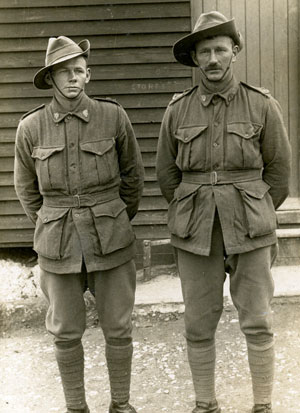
Currently on display in the Centenary of Armistice exhibition is a postcard from Pte. Wesley James Cockman, sent from England to his sister Francis Mabel Cockman in Wanneroo shortly before Wesley’s departure for the Western Front. It is dated 17 November 1917 and reads:
Dear Fanny
I am sending you this photograph. To tell you how, I think of you all, while we’re parted, from the happy shores of the dear old west, to just convey my dearest wish, and a message brief to cheer you. I hope the times not far away, when once more I’ll be with you all again on the happy shores of west Australia.
This photograph was taken after one of our hard days drill with full pack up. We are both doing well & going over to France very shortly now to do our little bit.
Wesley
This is one of a number of postcards with the image of Wesley and Ernest Cockman sent to different members of the family at this time. It is held in the Wanneroo Regional Museum Collection.
October Object of the Month
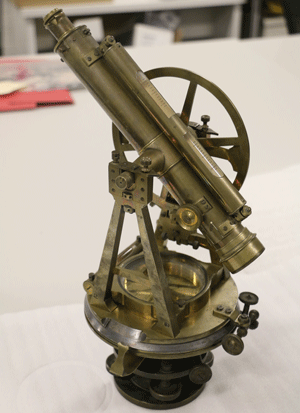
Owned and used by the City of Wanneroo, this theodolite was used in construction and mapping projects in the late nineteenth century. A theodolite is a surveying instrument with a rotating telescope for measuring horizontal and vertical angles. It has a long history with the City, having being used by Noel Bennetts who was the Shire Clerk from 1969 to 1981, who then passed it on to Les Swain, the Senior Engineering Surveyor from 1973 to 2015. The theodolite was passed on to current Senior Engineering Surveyor Ben Boylan who felt that it was such an interesting object that more people should be able to see and enjoy it and so passed it on to the museum. Of the theodolite, Ben says, “During my 18 years with the City I have been fortunate to be involved in the transition from manually operated instruments to automatic robotic instruments. The old theodolite was the very first iteration of measuring equipment and it fascinates me how far they have come.”
This theodolite was used as a prop in a photo published in the local paper for the WAY 79 celebrations. The photo was shot on the median strip of Wanneroo Road near Ariti Ave with Les Swain dressed in clothes of the era and using the theodolite.
The theodolite will soon be part of a new display in the museum.
September Object of the Month
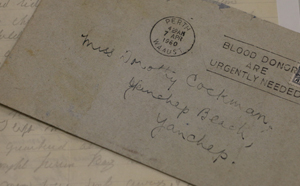
Written in pencil by the Hon. Mary Lindsay from St John of God Hospital in Subiaco, less than four weeks before her death. September’s Object of the Month is the Mary Lindsay Letter, written to Dorothy Cockman on the 4 April 1960. Dorothy is the daughter of Cecil (Tiddles) Cockman (1917-1995), who became the overseer manager at Mary Lindsay's Yanchep Estate property.
The letter responds to an enquiry from Dorothy Cockman about a pony called Mickie, one of the horses belonging to Mary Lindsay. The letter also talks about soldiers quartered at Mary Lindsay’s property at Jurien Bay and how they removed her fence posts for firewood.
Mary Lindsay’s former Yanchep home has recently undergone major redevelopment after conservation assessment determined there was too much asbestos in the building, and officially opens this month as the Mary Lindsay Homestead.
For more information about Mary Lindsay and the history of what was known as the Yanchep Estate, visit the Community History Centre at Wanneroo Library and Cultural Centre.
August Object of the Month
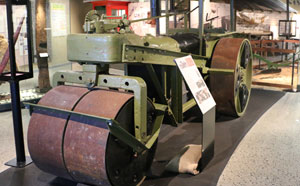
Visitors to the Wanneroo Regional Museum are greeted upon entry by this month’s object of the month, a Road Roller that once belonged to the Wanneroo Road Board and was crucial in the early construction of Wanneroo Road. The Road Roller had the honour of being the first museum object in the new Wanneroo museum building when it opened in 2009. Due to its size, it had to be installed when the building was still under construction and it stood in situ as the museum was built around it.
While in use, the road roller was driven by William (Bill) Kelly. The roller was utilised in the construction of Wanneroo Road and other roads in the area. He is remembered in Margaret Cockman’s oral history, available through the Wanneroo Community History Centre, “ My recollections are that there was an old Road Board roller that old Bill Kelly used to drive… …He used to drive that. He was an old guy with a real billy-goat beard. He did that for several years.”
Over time, the road roller fell into disuse and disrepair and ended up in a park, graffitied and rusted. It was restored at Wanneroo Youth Centre led by Bob Morgan and Larry Gane, a youth worker, who spoke to museum staff on the topic in 2013, “It was part of the Work- for- the-Dole scheme. There was a lot of elbow grease with wire brush to get it back to base metal. It was covered in rust and graffiti and we had to put a new roof on it. We didn't know it would end up in the museum.”
Visit the Wanneroo Regional Museum to see this significant piece of Wanneroo history.
July Object of the Month
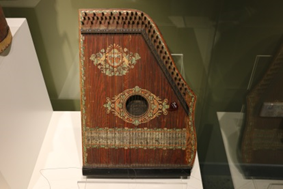
The museum object of the month for July is a Chord-Zither owned by the Krakouer family and donated by Ray Krakouer, caretaker of the Alkimos. A Chord-Zither is played on your lap or on a table, with melody plucked by the right hand while the fingers of the left hand strum across pre-tuned chords.
Ray shared this story of the Chord-Zither in his book, Yarns From The Alkimos, “I was enjoying my brew when the harpsichord [the Zither] started to sound off. Fair dinkum. It was twanging away and I thought I’m going round the twist. The ghost of Alkimos followed me home. I finished my drink, went over, turned the light on, while the harpsichord was still twanging away. Two blowflies were caught up in the strings and were trying to kick their way out. It just goes to show, things are not always what they seem."
Visit the Museum to see this object on display or visit the Community History Centre to find out more about the Alkimos.
June Object of the Month
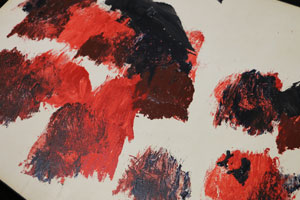
This artwork belonging to the Wanneroo Regional Museum will bring back fond memories for anyone who visited the Atlantis Marine Park from 1981 to 1990. Painted by one of the dolphins at Atlantis in the final days of its operation, it was first prize in a competition that called for members of the audience at Atlantis to come up and dance. The painting was won by Elsie Barton who was sat in the front row and who later kindly donated it to the museum.
Opening at Two Rocks in 1981 the Atlantis Marine Park at Two Rocks was a popular tourist attraction. Millions of people visited the park during its nine years existence, where they enjoyed attractions such as the performing seals and dolphins, and the oceanarium.
May Object of the Month
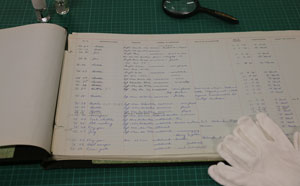
The Wanneroo Regional Museum has been around in different forms ever since the 1970s with the collection moving from Gloucester Lodge to Wanneroo Recreation Centre and finally to its present location at the state-of- the-art facilities at Wanneroo Library and Cultural Centre.
In honour of International Museums Day on 18 May, our May Object of the Month is the very first accession register documenting every donation that came into the museum in 1975. The tireless efforts and diligence of the volunteers and staff throughout the history of the museum, many from Wanneroo’s pioneering families themselves, informs many displays and exhibitions today.
April Object of the Month
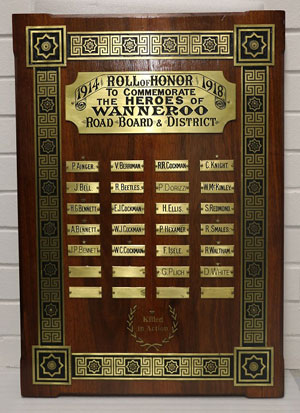
The Wanneroo Regional Museum object of the month for April is the Roll of Honour board from 1918.
For the month of April, visitors to the Museum will get the rare opportunity to see this important piece of Wanneroo history in honour of ANZAC Day.
For more information on the museum and it's opening hours, Visit: wanneroo.wa.gov.au/wannerooregionalmuseum #wanneroomuseum
